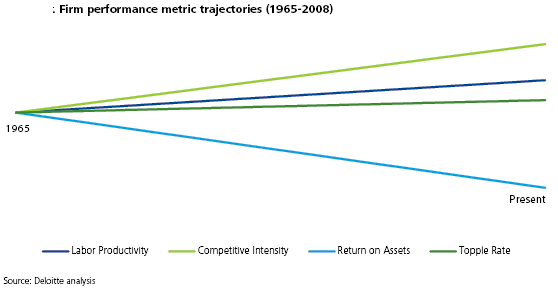The Deloitte Center for the Edge recently got my attention with its findings that competition is intensifying globally with a US return on assets dropping consistently across 15 different industries by 75% over the last 40 years!

Some other key findings:
US competitive intensity has more than doubled during the last 40 years. The “topple rate” at which big companies lose their leadership positions, has more than doubled, suggesting that “winners” have increasingly precarious positions. Customers appear to be gaining and using power as reflected in increasing customer disloyalty.
The exponentially advancing price/performance capability of computing, storage and bandwidth is driving an adoption rate for our new “digital infrastructure,” that is two to five times faster than previous infrastructures, such as electricity and telephone networks.
The Shift Index consists of 3 indices: Foundation, Flow and Impact, plus 25 other metrics that together quantify the stock, pace and implications for change. Given that competition is intensifying, here are some ways organizations might improve their performance.
1. Recognize the Foundation Wave: The business landscape has changed through the spread of the digital infrastructure and this has been reinforced by long term public policy that shifts towards economic liberalization. Changes in Foundations tend to reduce barriers to entry and movement, leading to a doubling of competitive intensity.
2. The Flow Wave looks at drivers of performance shaped by digital infrastructure. This wave looks at the flows of knowledge, capital, and talent enabled by foundational advances. Knowledge flows are the key to improving performance. This is a key area where many conventional businesses fail as they are too insular and have developed serious blindspots. This is the opposite of “Command and Control” leadership.
3. The Impact Wave comes last, as it will take time for companies to participate in and harness knowledge flows leading to improved performance and more innovation.
Successful firms will shift from what’s worked in the past, scalable efficiency to scalable learning.
This is a huge shift for most large US companies, and many of them are failing due to their closed nature, lack of flexibility and poor use of technology to gallop past competitors and collaborate with suppliers, customers and many other sources to develop innovative products.
Think Apple Computer when you think about a successful company by these “Shift Index” standards. Apple has kept its entrepreneurial magic largely by reaching out and being innovative in product development, and using all the technology, including social networks to continue expanding its connection to knowledge. This is a company that knows its customer. It’s no coincidence that Apple customers enjoy the experience of using its products. Who doesn’t just love their iPhone!
The conclusions and details of this study go far beyond what I can cover in a blog. I think a lot of what it preaches is what good competitive intelligence has been preaching for YEARS. Keep reaching out and connecting both internally and externally and build on the intelligence you gather. Stay connected with people through all the means technology allows you to reach them. Isn’t this the foundation of a good early warning system?
